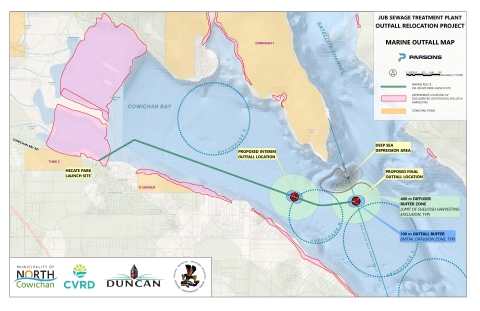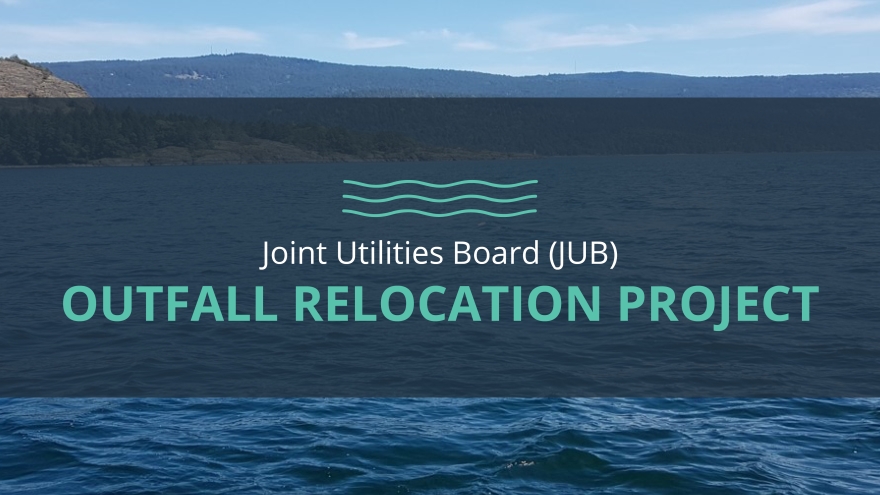Background
The Outfall Relocation Project will move the treated sewage effluent outfall which is currently located in the Cowichan River approximately five kilometres upstream from Cowichian Bay, to a more suitable deep water location at the embayment line of Cowichan Bay.
There are several reasons for relocating the outfall:
- The treatment plant is on land leased from Cowichan Tribes The lease agreement includes a commitment to make a reasonable effort to move the outfall from the Cowichan River.
- During periods of very low river flow, such as during summer and early fall droughts, there is not enough flow to provide the desired amount of effluent dilution. Low river flows are expected to become more frequent in the future, even with the raising of the Cowichan weir.
- During high flow periods, the existing outfall infrastructure is at risk of damage from log jams and gravel accumulation, and the treatment plant is at risk of flooding.
A further benefit is that moving the outfall from the river may trigger a reassessment of the current closure on shellfish harvesting in Cowichan Bay.
Discussion, public engagement, and other information is on North Cowichan's digital engagement site. Visit connectnorthcowichan.ca/outfall to learn more and have a say.
Proposed outfall location
Extensive studies, First Nations consultations, and engagement with the public and interest groups have identified a preferred location for the new outfall at the embayment line at the mouth of Cowichan Bay (see Map). At this time, Anchorage B is blocking the route to the preferred location.
North Cowichan is working with Transport Canada in the hope that this anchorage can be altered or removed before work begins. In the meantime, a suitable location for an interim outfall location has been identified if necessary.

An Environmental Impact Study (Receiving Environment Monitoring Program) (PDF) is guiding the project monitoring.
Pipeline routing
The cleaned effluent will be transported by pipe from the treatment plant to the new Cowichan Bay outfall.
The route through Cowichan Tribes land has been approved by Cowichan Tribes Chief and Council, but is subject to minor adjustments through ongoing consultations.
Most of the land portion of the pipe route will be buried along existing roads, including through the Cowichan Tribes’ Reserve lands and along Cowichan Bay Road from Maple Grove Park to Hecate Park.
The pipe will enter the bay at Hecate Park. For the most part the marine portion of the pipe will rest on the sea floor, with a section in the foreshore area being buried. Steps will be taken to mitigate any environmental impacts and replace and enhance the eelgrass beds.
About the sewage treatment plant and outfall
The Joint Utilities Board Sewage Treatment Plant is a hybrid secondary/tertiary treatment plant that treats wastewater. The plant and outfall serve approximately 14,000 households and businesses in parts of North Cowichan, Duncan, Cowichan Bay, Eagle Heights and Cowichan Tribes (the CVRD Central Sector Area).
The plant is located on Cowichan Tribes’ land near Duncan and is operated by North Cowichan. The plant discharges highly treated effluent (cleaned water) into the Cowichan River, approximately five kilometres upstream from the head of Cowichan Bay. While this effluent meets provincial swimming safety standards, it is not clean enough for drinking.
About the Joint Utilities Board (JUB)
The Duncan-North Cowichan Joint Utilities Board is governed by Duncan-North Cowichan Joint Utilities Agreement Bylaw 1977 and is comprised of two members from City of Duncan Council and two members from the Municipality of North Cowichan Council. The Board governs the joint financing, construction, operation and maintenance of certain municipal utilities and sewerage facilities for the benefit of both municipalities, including the sewage lagoons and outfall.
Additional background, reports, and studies
Visit connectnorthcowichan.ca/outfall for more background information, to review all background reports and studies, and to ask questions.
Additional Background Information and Detailed Reports
Contact us:
- Email: outfall@northcowichan.ca
- Phone: 250-746-3103

